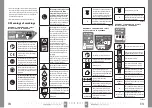
85
84
EN
EN
•
ATTENTION
y
When the nail gun is connected to the gas can,
a regular minor gas leak may occur, which has
a characteristic odour. Prior to storing the nail
gun, take the gas can out of it.
REMOVING A JAMMED NAIL (FIG. 8)
y
To gain access to a nail jammed in the driver head (fig.
8, step 4) or to remove accumulated paper from the
nail strip, it is necessary to disassemble the nail gun
in the sequence of steps 1 to 4 according to fig. 8, i.e.
in the reverse sequence of steps to the steps for the
assembly of the nail gun according to fig. 9 - see below.
For the purpose of illustration, it is possible to use the
alternative method for removing a jammed nail as
shown in the individual steps of the procedure in fig.
12, steps 1 to 3.
•
WARNING
y
Prior to disassembling the nail gun for the purpose of
removing a jammed nail or for the purpose of mainte-
nance, for safety reasons, first remove the battery and
the gas can, and only then remove the nail according to
fig. 8, step 1.
y
To remove the battery from the handle, first press the
button on the battery and then slide the battery out of
the grooves in the handle.
y
To remove the gas can, first gently slide the tube of the
gas can connection adapter off the connector on the
nail gun.
Fig. 12, step 1
Fig. 12, step 2
Fig. 12, step 3
Fig. 12, step 4
the magazine so that the plate of the shifter pushes on
the nail strip from behind.
In the event that it is necessary to replace jammed
nails, press the lever in the middle part of the shifter,
which will lift the plate that is pushing on the nail strip,
and subsequently whilst holding the shifter allow the
shifter to move to the front part of the magazine. Then
it is possible to slide the nail strip out of the groove in
the magazine.
•
ATTENTION
y
If the shifter is not firmly held when the compressive
plate is lifted, the shifter may spontaneously, forcefully
slide to the front part of the magazine, which could
damage the sliding mechanism.
INSTALLATION OF THE BELT CLIP (FIG. 4)
y
It is possible to hang the nail gun on a belt using the
belt clip.
y
The belt clip can be installed on either the right or left side
depending on whether the user is left- or right-handed.
INSERTING CHARGED BATTERIES (FIG. 5)
y
For the operation of the nail gun, a battery is necessary
as an electrical source for a spark that ignites the gas in
the cylinder.
y
Insert a charged battery into the respective part of the
handle, see fig. 5, step 2, so that it audibly clicks in and
thereby is secured in the handle of the nail gun.
y
The presence of voltage in the tool will be indicated by
a green indicator light on the handle, fig. 1, position 4.
VI. Operating the nail gun
Trial test (fig. 6) and setting the depth of the driven
in nail (fig. 7)
y
Prior to starting work with the nail gun, first carry out
a trial test on a sample piece of material, into which the
nails will be driven, and adjust the depth of the driven
in nail according to fig. 7 if necessary.
•
WARNING
y
Before starting work, ensure that the material into which
your intend to drive nails contains no undesirable items,
e.g. hidden electrical conduits, metals (pipes), stones,
etc. Otherwise, injury or material damage may result.
•
WARNING
y
During work, use certified
eye and ear protection with
a sufficient level of protection
and prevent access to any flame sources.
y
To operate the nail gun, first apply the compressible
contact safety mechanism to the surface of the work-
piece and then push the nail gun against the surface,
so that the compressible contact safety mechanism is
compressed, and by pulling on the trigger drive out the
nail (fig. 6, step 3).
y
Then lift the nail gun off the surface of the workpiece
and move it to the required location where the next nail
is to be driven and drive in the nail/staple according to
the procedure described above.
•
ATTENTION
y
When pulling the trigger, it is nece-
ssary to properly push down the
nail gun against the work surface
and when the nail is driven out to hold it down with
sufficient downward force, otherwise the nail may not
be properly driven into the material as a result of a loss
of impact force when the nail/staple gun is kicked off
the work surface.
•
ATTENTION
y
The nail gun is not intended for driving nails into mate-
rials other than wood or wooden materials or materials
with properties similar to that of wood. The nail gun
must not be used to drive nails into hard materials such
as, for example, steel or concrete! When driving nails
into wood on a steel, concrete, etc. base, it is necessary
to apply a greater downward force due the greater
generated recoil and to prevent the gun from slipping.
When driving nails into wood on a steel, concrete,
or other hard material, it is necessary to select a nail
length that will preclude the nail from hitting the base,
otherwise a reactive recoil may result.
The battery is equipped with protection
against full discharge, which damages it.
Battery protection prevents the voltage
from falling below a certain threshold that
is damaging to it.






































